The fall season is, by far, the most rewarding time of year for any landscape photographer. Nature’s transformation rewards us with unique color pallets that exist only during the season of fallen leaves.

The fall season is relatively long and, depending on the year, can last anywhere between 50 and 90 days. What truly makes this time of year unique is that nature’s transformation is in constant flux. The temperature, wind, and humidity affect the speed of the transformation and we, as photographers, must be ready to capture different stages of the season as it changes.
For example, a cold night with negative temperatures during the peak of the fall season will accelerate the changing colors of the foliage. The landscape will look different the following day.
Another example is the frequent fall storms that are notorious for blowing the leaves off the trees, completely changing the look of a scene in just hours.
What this means is that you can’t afford to wait for good light or favorable weather. If you find an interesting composition with exciting colors, you have to seize the opportunity right away before it vanishes.
Autumn photography is not very different from traditional landscape photography, but it does have one main distinguisher—the unique colors of the leaves. The goal of fall photography is to locate and naturally incorporate the autumn foliage into landscape compositions.
Fall Photography Ideas and Tips
Today, I will share my favorite ideas and tips with you on how to approach foliage photography.
01. Ongoing (Perpetual) Scouting
My best scouting tip for fall photography is to scout locations all year long.
For example, you may come across an interesting composition of a water reflection only to realize that the green leaves in the reflection are not as appealing during the summer months. You might consider returning to the same location in the fall to see if the yellow and red foliage make the composition more attractive.
Capture the scene with your mobile phone and save it to the Fall Foliage Ideas folder in Evernote (this is what I do). Another option is to pin the photo to a custom Google Map (My Maps). If you do this throughout the year, when autumn arrives you will have plenty of ideas for foliage photos.
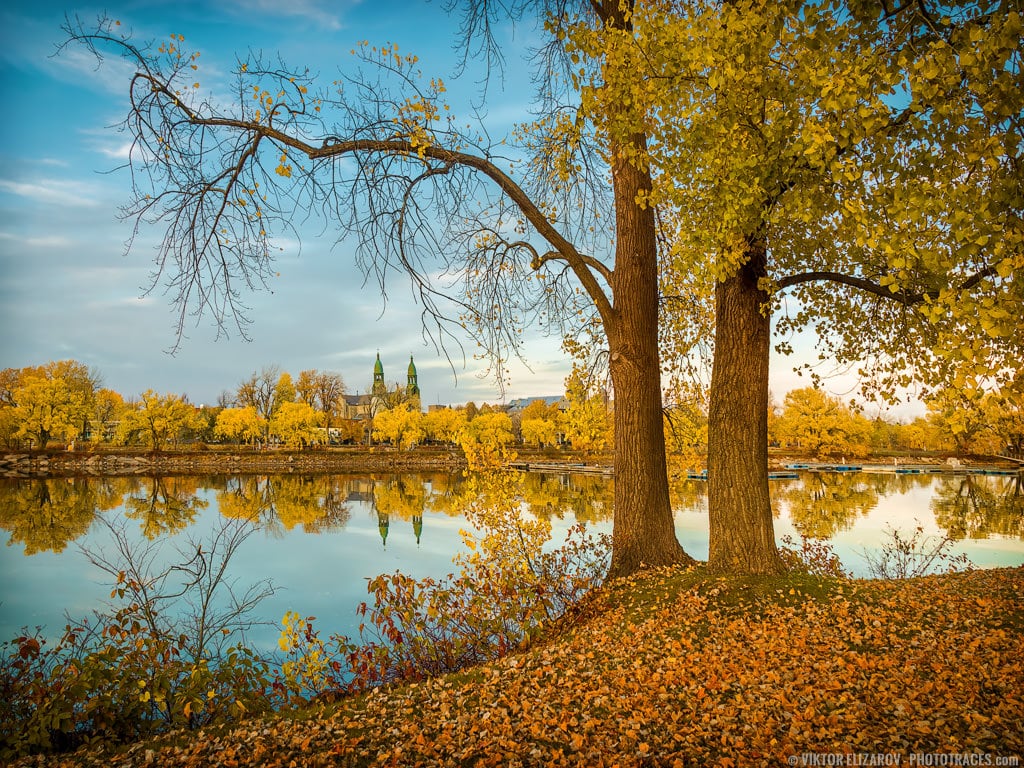
02. Use Online Tools to Research Your Specific Location
Every fall season is different. Depending on the weather during the spring and summer, color changes can start earlier or much later. The transformation can last a full three months or disappear after a brief six weeks. Freezing conditions can prematurely end the colorful fall foliage, which is often what happens in Eastern Canada where snowfall in early November is not uncommon.
I also remember that we did not have any exciting autumn foliage around Montreal for three years in a row. My guess is that extremely dry summers affected the colors.
Another important factor that affects the timing of the fall color transformation is altitude. The higher the elevation, the sooner the transformation starts. Even a small elevation of 500m can yield a change in timing by weeks.
The good news is that we can research a specific location before we leave for our color hunting expedition.
For example, in the province of Quebec where I live, I use an interactive map called The Enchantment of Colors.
Here are a few other online resources I have discovered over the years:
Simply do a little research on Google to find foliage reports for your specific location.
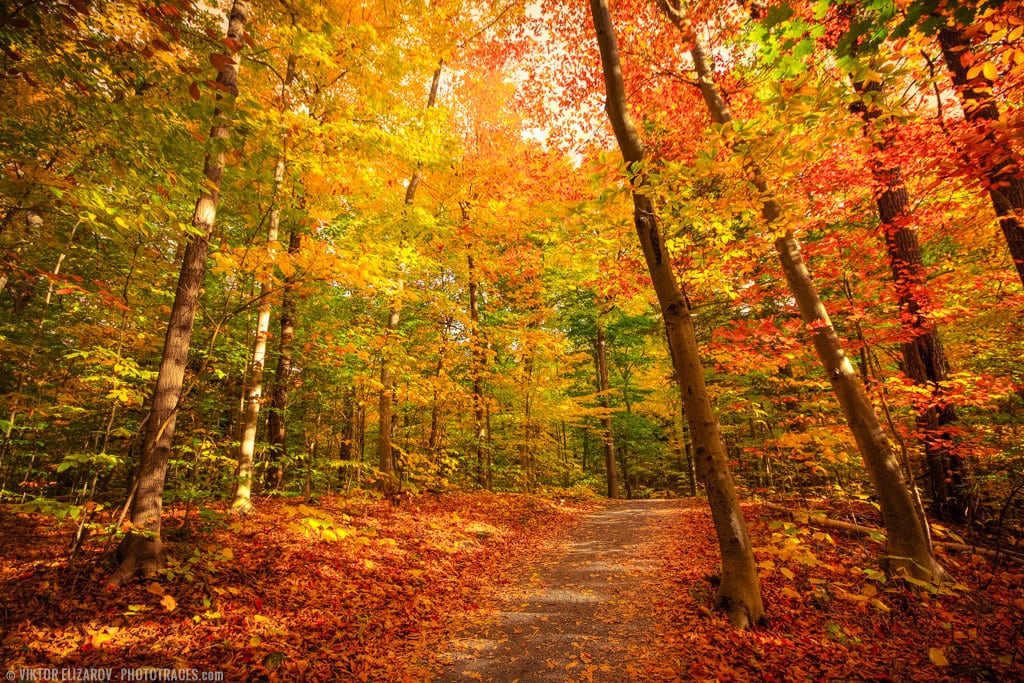
03. Do Not Fear Gloomy Overcast Days
From a photography standpoint, I find that the autumn season is more forgiving in regard to unfavorable light. Most photographers prefer to stay home during overcast days when grey clouds serve as a giant diffuser canceling the contrast and desaturating the colors.
But, during autumn, not even a boring overcast sky can eliminate the vibrant foliage colors. The colors are present in every composition and, even if their intensity is reduced, it is easy to bring them back to life during post-processing.
Overcast days during the autumn season give us the opportunity to photograph the entire day without worrying about the sun’s position.
I love overcast autumn days when the quality and intensity of light does not change throughout the entire day. It creates an almost studio-like controlled environment for landscape photography.
The light is constant, the shadows are soft, and the muted colors blend nicely together to create a painting-like scene.
The only challenge during overcast days is to minimize or even eliminate the boring white or grey sky from the composition. My favorite trick for dealing with a boring sky is to shoot from inside the forest where the trees shield the sky completely.

4. Find Water. Make Mirror Reflections
The mirror water reflection is, by far, my favorite autumn photography technique. When you have an abundance and a variety of colors that create excitement and drama in your composition, you can double it by introducing reflections.
The main challenge when creating mirror reflections is to have quiet windless weather. Quiet days are rare where I live. My favorite tip for finding perfect mirror reflections is visiting small lakes surrounded by the forest. In places like this, you can find quiet corners even on a windy day.

5. Create Autumn Abstracts
I truly admire impressionist paintings, especially the work of Claude Monet. Every year, autumn colors inspire me to experiment with more abstract concepts by creating dream-like compositions.
My favorite technique for creating autumn abstracts is to photograph water reflections and make them the focal point of the composition. In such cases, I do not need perfectly still water. I want slowly running water, which helps me produce the blurry, dreamlike effect that you often find in abstract or impressionist paintings.

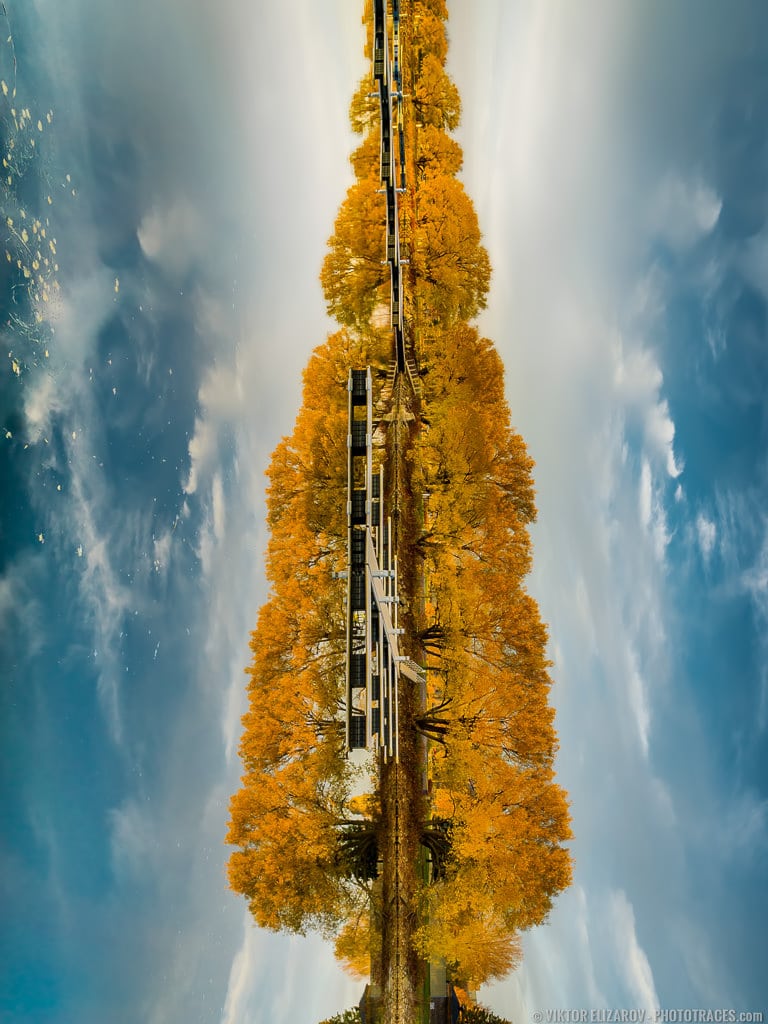
6. Take Advantage of Sunrises
Light is different throughout the day because of the position of the sun. At midday, the sunlight falls almost vertically and the diffusing effect of the atmosphere is minimal. This results in sharply-lit high contrast photos that do not look as pleasing to the eye.
In the morning and at the end of the day, however, the sun is closer to the horizon and it takes light longer to enter through the atmosphere. That’s why photos taken at sunset have softer shadows and highlights.
Another characteristic of morning and evening light is its warmth. When light travels through the atmosphere, its particles scatter the blue spectrum of light, which makes the light warmer. The longer the light travels through the atmosphere, the warmer the light becomes. For that reason, 30 to 60 minutes after sunrise and 30 to 60 minutes before sunset are considered to be the most favorable times for landscape photography. This is known as the Golden Hour.
For my landscape photography, I prefer sunsets over sunrises because they often produce more dramatic photographs. But, for autumn photography, sunrises give us more opportunities to create interesting and clean shots. Cold autumn nights produce much cleaner air by reducing haziness. Another benefit of shooting at sunrise is the chance to encounter the morning mist, which can enhance any composition.

7. Use Backlighting Technique
Backlighting is probably the most popular technique when shooting autumn foliage.
Here is how it works. When you position the foliage between the camera and the sun, the foliage is illuminated from behind to create a translucent and radiant effect of glowing light around the leaves. At the same time, the foliage diffuses the light and makes it much softer than direct sunlight.
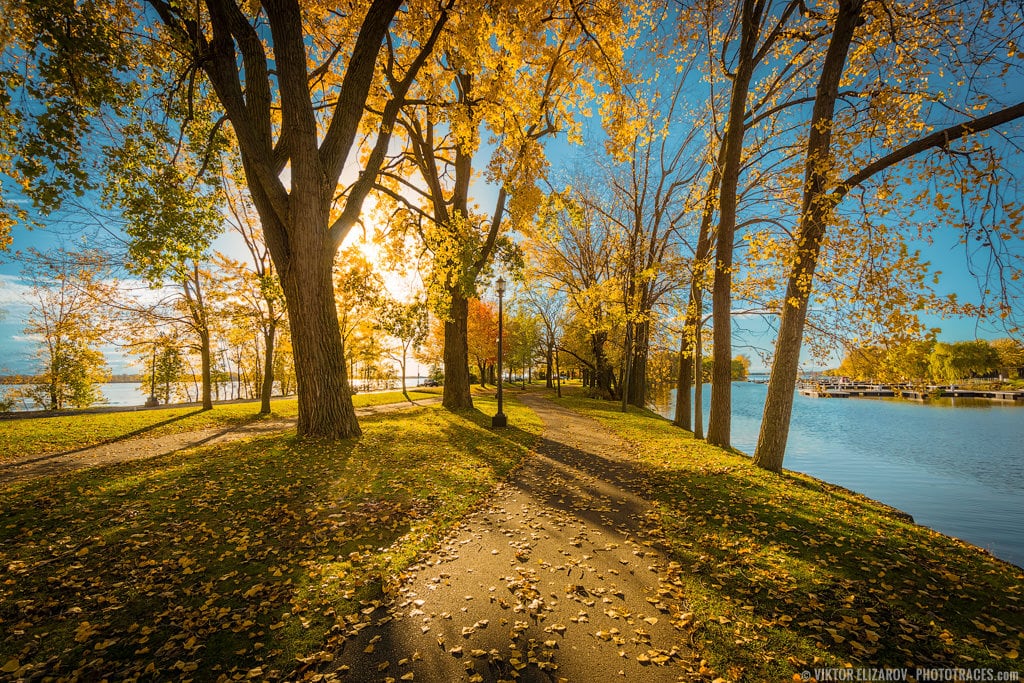
8. Shoot Directly Into the Sun for a More Dramatic Effect
To add even more drama to an already dynamic scene, try shooting directly into the unobstructed sun. This can be technically challenging and require the use of exposure bracketing in combination with the HDR technique, but it is incredibly rewarding since the shots can produce a unique and climactic composition.

9. Use Polarized Filter
I am not a big fan of using filters in my photography. Over the years, I gradually eliminated most of them from my routine because it is easier for me to recreate the effect of the filters during editing. But, there is one exception—I still use a polarized filter.
There is a common misconception that the main function of polarized filters is to enhance the colors of the scene especially the blue colors of the sky. But, this is not true. Even though the polarized filter affects the colors in our photos, you can achieve even better results with greater precision in post-processing.
The main function of the polarized filter is to reduce reflections and glare. I find it is the most useful when shooting autumn foliage after the rain. The water drops on the leaves can produce an undesirable glare by reflecting the sunlight. The polarized filter can drastically reduce this glare.
Another reason to use polarized filters is that its antireflection effect cannot be recreated in post-processing.

10. Embrace Bad Weather
When analyzing my old photos, I realized that bad weather equals better and more dramatic photos.
This is how it normally works. You walk in stormy weather and all you see is the dark, moody sky. But, there is suddenly a small opening in the clouds and the beam of sunlight illuminates part of the scene. The colors and contrast create unbelievable drama. The moment lasts only minutes, just long enough for you to take your best photo of the year.
The problem with these types of shots is that you cannot plan them in advance. All you can do is show up and be ready for anything. The more time you show up, the higher the chance that you will capture something amazing.
In autumn, you have even more chances to capture natural, dramatic scenes because, as autumn progresses, the weather gets worse and worse.
The combination of a weather-sealed camera and weather-sealed lens is a tremendous help when it comes to dealing with bad weather. Since I upgraded my camera to a weather-sealed version, I find myself more and more willing to go out and shoot in any weather. I have no more excuses to stay home during the autumn rain.
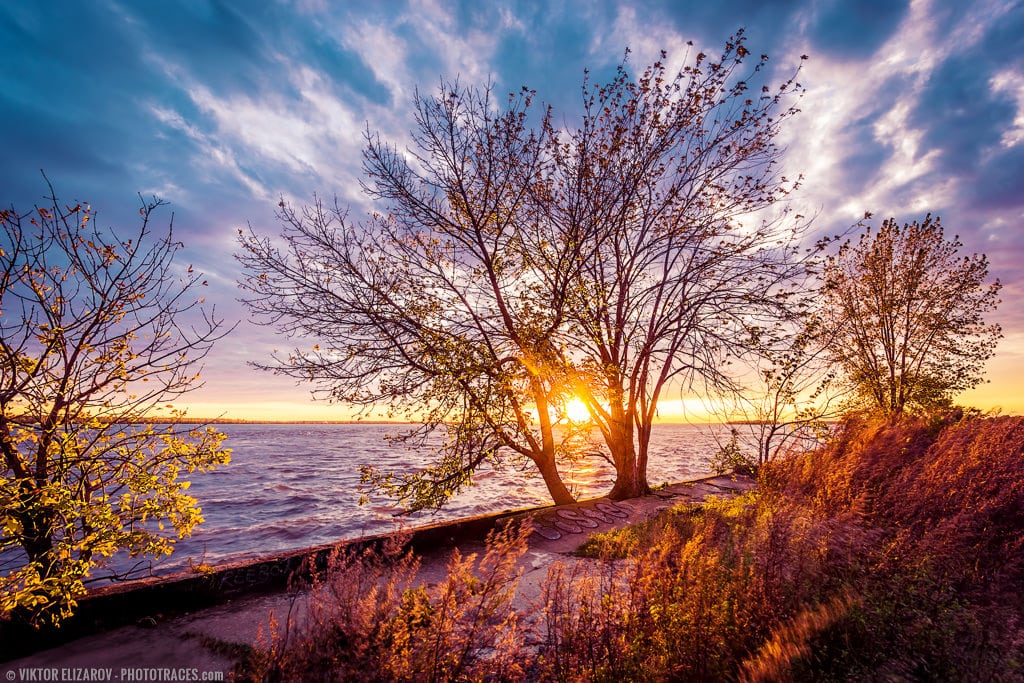
11. Shoot RAW
This tip is not exclusive to autumn photography. I always recommend shooting in RAW format regardless of what type of photography you pursue. But, for autumn foliage photography, shooting in RAW is even more relevant. RAW format gives us more latitude to manipulate the colors of photos with even greater precision. When using RAW editors like Lightroom, you can achieve your creative vision even easier when targeting individual colors in your RAW image.

12. Use Presets
Since we take and edit fall photographs only for a short period of time, it makes sense to create a dedicated preset collection. The collection you can reuse year after year. The idea is you do not have to start editing from scratch every September.
Another alternative is to grab my Fall Colors Collection and create your own presets using Fall Colors as a foundation.
Fall Photography Ideas and Tips: Final Thoughts
The fall season offers a multitude of opportunities for capturing stunning foliage photos. By following these 12 ideas and tips, you can enhance your photography skills and capture the beauty of autumn in all its glory.


